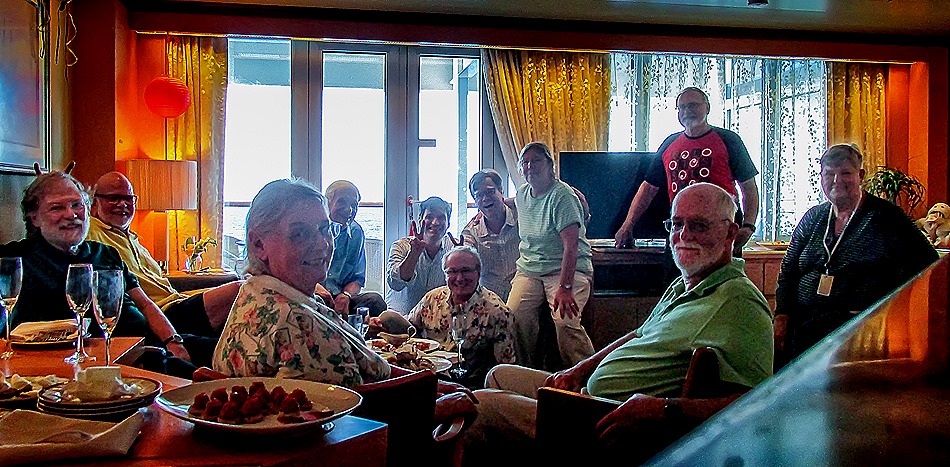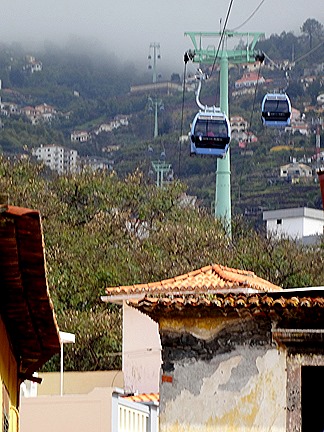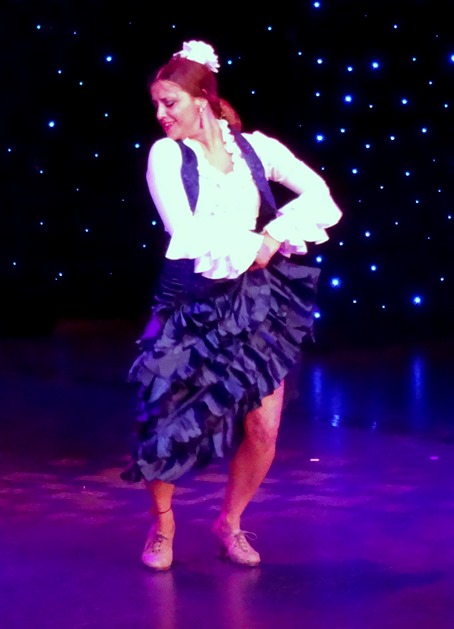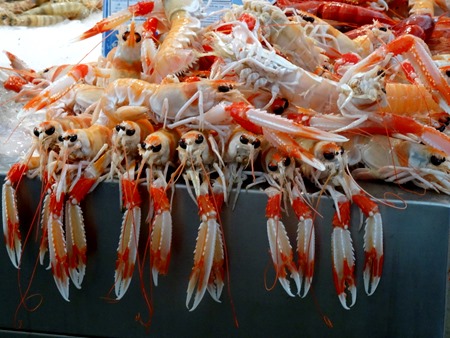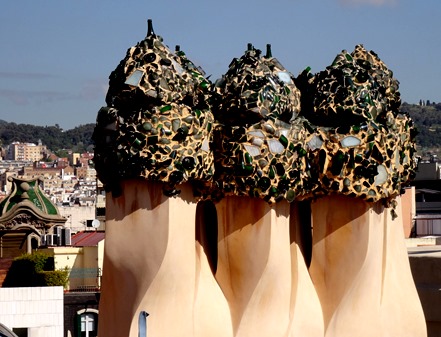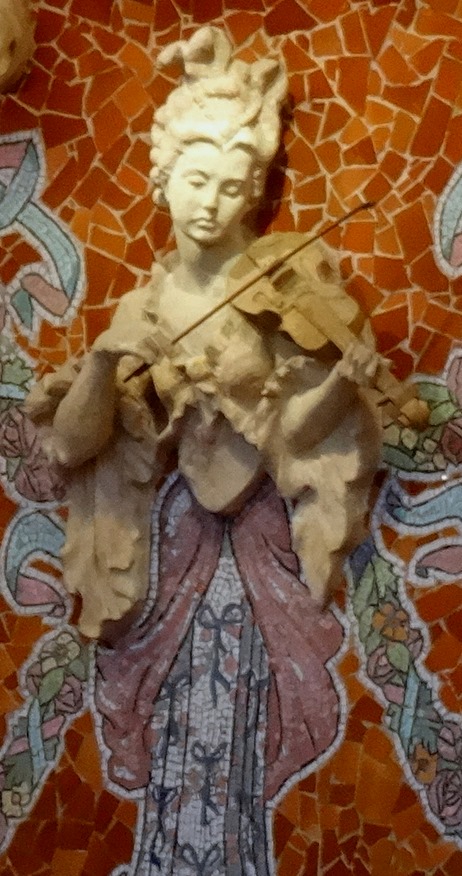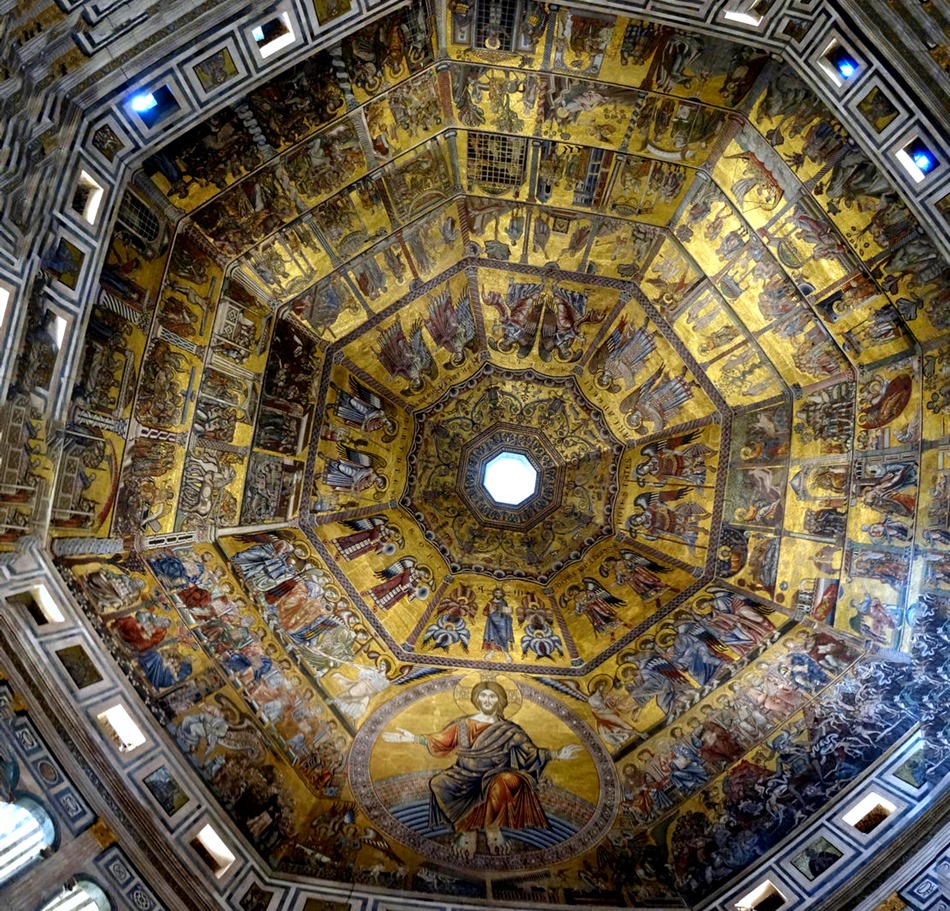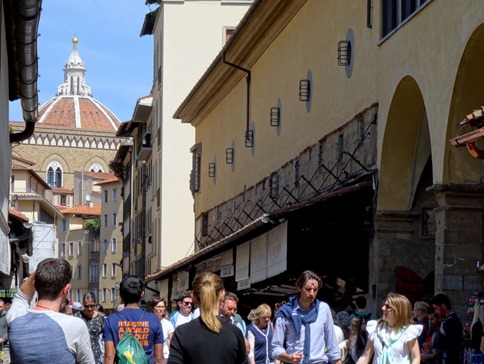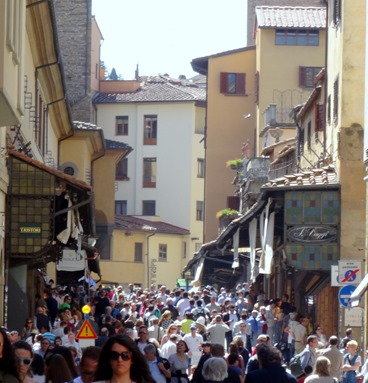Rounding Third & Heading for Home*: Crossing the Atlantic
*With apologies to the old lefthander, Joe Nuxhall
After leaving Madeira we spent a full week at sea crossing the Atlantic to Ft Lauderdale, where we would exit the ship on the morning of April 30. There was a lot going on during that week, with people preparing to leave the ship, goodbye parties, performances, etc. So here’s a taste of all that.
HAL’s crews are mostly Indonesian & Filipino (HAL has a training facility in Indonesia), and each group put on a show of song & dance from their native country. Both shows were colorful & entertaining & it was fun to see the talent of some of our regular waiters, wine stewards, room attendants, etc.. First the Indonesian show.
A few days later the Filipino staff presented their show. Our wine steward for the last part of the trip, who was called Nestor, produced, directed & was one of the star performers in this show. He did a great job.
There were several other notable voyage ending concerts. First, David & Attila, the excellent violin & piano duo that played in the Explorers’ Lounge every night under the name of Adagio, had a concert on the stage in the Queen’s Lounge backed by the Amsterdam Orchestra. They are always very good, but maybe a little better in their natural habitat. They really don’t need any accompaniment.
An amazingly good steel drum group called Island Magic gave two performances during the last week. Not just the expected Calypso music, they played classical & swing numbers as well. You haven’t heard anything until you have heard classical music played on steel drums! At their first concert they started out with three Andrew Lloyd Weber pieces & we weren’t sure we wanted to stay for an Andrew Lloyd Weber tribute concert, but then they proceeded to a more interesting mix of music & we were really glad we stayed. The two front players even engaged in some Pips style choreography a few times. Great show.
There was a final musical extravaganza that included most of the musicians who had been with the ship throughout the voyage. It opened with the Amsterdam Orchestra playing with the singers from the production ensemble from the second half of he trip. Sebastian, the superb guitarist with the Amsterdam Orchestra, was showcased for a few songs, at least one of which he wrote himself. Debbie Bacon from the Piano Bar played a rousing six handed piece with Michael & Connor, the keyboardists with the Amsterdam Orchestra. The Neptunes, a very good jazz trio when they aren’t just playing for dancing, performed & then David & Attila were back on the main stage for another piece backed by the Orchestra. The lead singer with the dance band from the Crow’s Nest, whose name we don’t know, gave a dynamite performance of Man of La Mancha and Michael & Connor were back for some four handed piano. There was more, but we had to leave for dinner.
And so it was time to pack up (a big job after four months) & say goodbye. There was an assembly for that in the Queen’s Lounge, where Captain Mercer & Gene the Cruise Director spoke, among others. Barbara, the travel guide, presented a five minute(!) recap of the entire four month journey, complete with pictures.
Time for one more party, a champagne get together in Robert & Bill’s suite, then it was time to disembark on the morning of May 30 (that part wasn’t fun). Here is a last picture of the group that shared our table for the full four months, time enough to get to know each other very well. We were lucky; it was a really good group of table mates who got along really well the whole time. One person compared it to a family, but Rick disagreed because we never fought with one another. Here we are with a special order of one of our favorite deserts (well, favorite of everybody but Robert & Mary), a Cappuccino Bomb consisting of a large hunk of cappuccino ice cream enclosed in hard chocolate.
The day we disembarked we had lunch with John & Karen, friends from a previous cruise, a little way north of Ft Lauderdale, then dinner with Ada & Chuck, also friends from a previous cruise, in Miami. We greatly enjoyed seeing them all, but we should have taken two days. Then we spent a few days with Michael & Irene, Mary’s aunt & uncle, in St Petersburg & another night with Barb & Bing, more friends from previous cruises. In South Carolina we had dinner with Linda & Paul, Rick’s cousins, then made it home the next day. It was really nice seeing all of these people who we hadn’t seen in some time, but what a social whirl! We were very tired when we finally got home, but just three weeks later we were off again on a three week driving trip to Texas & Minneapolis to visit family. So that partially explains why it took so long after we got back to complete this blog!
So that’s it for this truly epic journey, a true circumnavigation of the globe (which we discovered requires you to pass through two points on precisely opposite sides of the world . . . ours were near New Zealand & Gibraltar)). This is truly a once in a lifetime trip . . . unless you do it again, which we just might. So long until next time.
Funchal, Madeira, Portugal
On April 22 we were docked in Funchal on the Portuguese island of Madeira. The last time we were here, we took the cable car up to Monte & an excursion around this exceptionally beautiful island. See https://baderjournal.wordpress.com/2013/03/27/madeira-day-1-funchal/ and https://baderjournal.wordpress.com/2013/03/27/madeira-day-2-around-the-island/. We were pretty tired of bus trips by the time we arrived here this time (our last one for this voyage was to Florence), so we decided to spend the day walking around Funchal. We had planned to take the cable car up the mountain to Monte because last time we went up there it was late in the day and everything was closed. Some friends of ours took a bus excursion there early in the morning & said the views were fine but by the time we left the ship in miid-morning the mountain was enclosed in a cloud & it pretty much stayed that way all day, so we abandoned that plan.
Instead, we took the shuttle bus in to the edge of town & spent some time in the Jardim Municipal (Municipal Gardens). This island is famous for its abundance of beautiful flora, and we were there in early Spring when much of it was in bloom.
The gardens also have a lovely pond with swans, ducks & fountains.
We walked into town through the attractive streets of Funchal to the Municipal Plaza. The town hall is on one side of this square, but we visited the beautiful Church of St John the Evangelist that was across the way. Built in the 17th century, this church is connected to a Jesuit college. Its façade is fairly plain, in the Portuguese style of white walls outlined with dark (volcanic?) stone. In contrast, the inside is a fantasy of frescoed walls & ceiling with gilded altar pieces and tiled sections.
The Mercado dos Lavradores (Farmer’s Market) is a building several stories high with an open central courtyard. It was built in 1940. The mostly open first floor is crowded with flower, fruit & vegetable stands selling local produce under umbrellas to protect from the sun. The second floor has more fruit & vegetable stands, where vendors offer free samples, then charge exorbitant prices for more. There are also crafts & souvenir stores on this level. In the back are the butchers, hacking away at the fresh catch. It’s a very colorful market, well worth experiencing, but not a good place to actually buy fruits & vegetables because of the prices.
We walked through the old section of town behind the market, now the location of many cafes & art galleries, then out to the East side of Funchal. There we came upon the Church of Santa Maria Maior (although it also goes by other names), apparently built in the 18th century on the site of a 16th century chapel dedicated to St Tiago that was constructed to hold off an epidemic. The church was closed, but its outside was quite nice in the Portuguese black & white style.
Nearby on the waterfront is the dark yellow Fortress de Sao Tiago, built in 1614 to protect the city from pirates. Today it houses an upscale restaurant & art galleries. The best things in this area, though are the views of the coast.
Walking back toward town provided more nice views of the city & the waterfront. We also passed an archaeological site uncovering some 15th century housing & wells and an original city wall built in the late 16th century. There were many beautiful flowers along this walk as well.
One of the distinctive aspects of walking through a Portuguese city is the black and white mosaic sidewalks in many different patterns. Funchal is no exception. We always enjoy these (although the best are in Rio).
We passed the 15th century Cathedral of Our Lady of the Assumption, known for short as the Se Catedral. It is supposed to be quite beautiful inside but it was closed the day we were there (this sure seems to happen a lot). We passed the municipal garden one more time & boarded the shuttle back to the ship.
So ended our final day in port, an enjoyable walk through a lovely city. Not as spectacular as many of the ports we visited on this voyage, but a good one for winding down toward the end. Of course, it was not really the end because we still had a week to spend at sea crossing the Atlantic to Fort Lauderdale. A little more on that anon, but for now we will leave with a parting look at Funchal.
Cadiz, Spain
We spent April 20 in Cadiz. We had previously docked here in 2013, https://baderjournal.wordpress.com/2013/10/11/cadiz-seville-spain/, but we spent that day visiting Seville (a completely worthwhile trip) so Cadiz itself was mostly new to us. Cadiz is on the Atlantic coast, outside the Mediterranean. Founded by the Phoenicians in 1104 BC, it is considered to be the oldest continuously occupied city In Europe. In the 17th & 18th centuries Cadiz became very wealthy as the terminus for the American gold & silver trade after the river to Seville was blocked by silt. The city was mostly destroyed in 1596 by Sir Francis Drake, so most of the old city dates from the 17th & 18th centuries. Central Cadiz is located on a large peninsula jutting out into a bay, so there is water all around it. The cruise ship port is right downtown, giving quite a view of the city from the ship.
The night before reaching Cadiz there was a performance by a Flamenco group, dancers and a superb guitarist, who sailed with us for several days through Spain. The guitarist had given an intimate solo performance for a small audience in the Crow’s Nest bar earlier in the afternoon, which whetted our appetite for the full performance at night on the main stage of the Queen’s Lounge. It was not a disappointment!
Cadiz is unusually visitor friendly. Across the street from Amsterdam’s berth is a large park, at the end of which is the tourist information office. They gave us a map of the city marked with four color coded walking tours. These tours are actually marked on the streets themselves in the color indicated on the map, so it was pretty easy to follow. We followed (loosely) the green walking tour of the old part of the city.
Our first stop was Plaza de San Juan de Dios, laid out on land reclaimed from the sea beginning in the 15th century. The plaza is dominated by the old town hall, built between 1799 & 1861. In front of it on the plaza is a statue of a Cadiz politician erected in 1906, when the plaza was also expended after the city walls were demolished.
The attached building with the brown tower to the left of the town hall is the church of San Juan de Dios, formerly the Misericordia Hospital. It was built in the late 17th century & is quite elaborate inside with a small but beautiful pipe organ. We had not previously seen (or at least noticed) pipes facing forward like those in this organ.
The old part of Cadiz near the city hall, called Barrio del Populo, is famous for its picturesque narrow winding streets. Among other things, we came upon the Casa del Almirante (Admiral’s House), built in 1690 by Don Diego de Barrios, admiral of Spain’s American treasure fleet.
The Cadiz Cathedral was built between 1722 and 1838 on the site of the previous cathedral, which was built in 1260 & burned down by the English in 1596. It is one of the largest in Spain. It has a golden dome and two towers, and appeared from the ship to tower over the city on the opposite side of the peninsula. There was a good bit of construction in progress when we were there so we didn’t go inside.
On the left side of Cathedral Plaza is the Arco de la Rosa, one of the gates of the medieval; city walls built in the 12th century. On the other side is the Church of Santiago. It was rebuilt in 1635 after the English plundered the city in 1596. There are several 17th century gilded Baroque altarpieces inside & a single octagonal tower on top.
The Plaza de Las Flores is an oblong plaza full of flower vendors & cafes. It is pretty but also popular and therefore crowded. On one side of the plaza is the Correos, the main post office, an attractive brick building with a novel mail slot. On the other side is the Mercado Central (Central Market). The market’s outside walls with porticoes date to the mid-19th century and the central buildings were added in 1928. We saw mostly fruit & vegetable stands and fresh seafood (some still alive) & butchers.
Not too far from the mercado is the Palacio de los Marqueses de Recano, built around 1730, which is typical of the mansions built by merchants in the American trade. It is on the highest spot in the old city, some 45 meters above sea level, and on top is the Tavira Tower. In the 18th century there were more than 160 such watch towers used by merchants to look for ships arriving from the sea. The Tavila Tower is the tallest one remaining; in 1788 it wa designated as the watchtower for the port of Cadiz. The tower reputedly gives a fine panoramic view of the city & also contains a camera obscura that is supposed to be interesting. But its about 170 steps to climb to the top and Mary was still feeling the effects of the Dubai illness, so we didn’t go up. Across the street is the 18th century Hospital de Mujares, one of the first women’s hospitals. You can see below that its façade is interesting, with unusual cross shaped windows on the second floor. Inside is a courtyard with stone staircases leading to the upper floors, but the gem is an extremely elaborate gilded chapel, sharply contrasting with the grey stone of the rest of the building, inside which is a magnificent painting by El Greco of St Francis in Ecstasy. Sadly, no photography was allowed inside the building so we have only the picture of the façade to include here.
Just up the street from the Tavira Tower we discovered the Municipal Library, so you know we had to visit that! It was very nice, with white balustrades around a central atrium reaching to the 4th floor.
We wandered the interesting & sometimes crowded streets of the city for awhile on our way to the Cadiz Museum. The streets are probably the most interesting things to see in Cadiz.
The Cadiz Museum sits on the quiet Plaza de Mina. The museum is quite interesting, although the lack of English signage limits its enjoyment by folks like us. The first floor is the archaeological museum, containing many artifacts from Cadiz’s long history. But its prime exhibit is a pair of Phoenician sarcophagi. As mentioned above, the Phoenicians founded Cadiz (or as they called it, Gadir) around 1100 BC. The male sarcophagus, uncovered in 1887, was the first item in the archaeological museum, & was later joined by the female sarcophagus that was uncovered in 1980. There is also a large statue of the Roman Emperor Trajan, who was born not far from Cadiz. The second floor is filled with art, mostly Spanish painting, and the third floor (which was closed for renovations when we visited) contains a collection of large puppets used in local festivals.
I failed to mention earlier that it was a chilly & drizzly day. We emerged from the museum to discover that there had been a downpour while we were inside (good timing). As a result the streets & plazas were much less crowded than they had been during the morning. We visited the small 18th century Oratorio de la Santa Cueva (Holy Cave), which got its name from a subterranean cave that was converted into a chapel. The stark underground chapel has a dramatic painted wood crucifixion sculpture. On the top floor is a very richly decorated elliptical chapel with a dome. This chapel has five semicircular paintings, three of which are by Francisco Goya.
It was still drizzling on and off as we strolled to the water front on the far side of the peninsula from the cruise port, behind the Cathedral. In addition to the dramatic curved waterfront we saw the 1st century AD Roman Theater, discovered only in 1980. One of the largest theaters in the Roman empire, it could accommodate some 20,000 spectators. Next to it was a pile of spiral columns, which may or may not have been part of the theater.
On our way back to the cruise port we stopped by the Plaza de Espana to see the monument to the 1812 constitution. This was Spain’s first republican constitution, written in Cadiz while Napoleon occupied the rest of Spain. The monument was begin about 100 years after the constitution was written & completed in 1929. The text of the constitution is displayed on the tall pillar in the center, with a statue representing justice at its base.
Getting back into the port was something of an ordeal because guards at the gate required many people to empty their pockets. But before long we were back on the ship for our departure from Europe, with only one more port to visit before the end of the voyage. So here is one last look at the panorama of Cadiz from the ship before we sailed away.
Barcelona, Spain
We docked in Barcelona on April 18, the last of four consecutive days in different ports. We had been to Barcelona in 2013, https://baderjournal.wordpress.com/2013/09/11/barcelona-spain/, & were hoping to see the Picasso Museum, which had been too crowded for us to visit last time. But it turned out our visit was on a Monday this time, so all the museums were closed. Maybe next time.
We were docked pretty far down from the entrance to the harbor; one of the new Viking ocean ships had the berth right next to the entrance. There was a shuttle bus to take us from the ship to near the Columbus monument at the base of the Ramblas. Unlike every other port we visited (and unlike our last stop in Barcelona 3 years ago), the shuttle cost 5 Euros a person. Everyone found this irritating; many thought it was cheap of HAL not to pick up this small cost for its Grand Voyage guests. Some folks refused to use the shuttle & walked the mile or so into town, but since Mary was still feeling the effects from Dubai we took the shuttle.
We had two goals for the day. First, on our last visit we saw quite a few of the buildings created by local icon Antoni Gaudi, but only saw the inside of one, the Sagrada Familia church. This time we wanted to tour the inside of one of his residential buildings, Casa Mila, nicknamed La Padrera (the stone quarry) because of its looks. Completed in 1911, this was Gaudi’s last commercial project, subsequently concentrating exclusively on religious works. Very controversial in its time, today La Pedrera is a UNESCO World Heritage site.
To get there we walked up the Ramblas, past the monument of Christopher Columbus pointing to the new world, reputedly at the spot where he came ashore in 1493 after his first voyage. The Ramblas, one of Europe’s great boulevards, Is a pedestrian road flanked by trees & then two narrow streets. Usually crowded & busy, full of locals & tourists & vendors & cafes, it is a relatively serene & pleasant venue for an early morning walk. Among other things, we passed a woman getting dressed as, presumably, one of the living statues we would see later on our return. Further up we passed an interesting building on a corner with a street sculpture of a book outside it. Everywhere you go in this city you see buildings with interesting & unusual architectural flourishes.
We had read that lines to see the inside of Casa Mila could be as long as an hour & a half, but there was almost no line at all when we arrived. This is probably due to the morning hour & the date, before the real tourist season. The entrance was through the central courtyard of the building, open at the top, which gave a view all the way up. There is a stairway to the second floor, with painted decorations, pillars & plants. But the first stop on the self-guided audio tour is the roof, reached by an elevator.
The rooftop is a wonderland, a giant sculpture garden of chimneys with excellent views thrown in. It was pretty crowded with visitors, but still quite beautiful. On the inside you could look over the courtyard atrium, with its undulating curved lines.
On the outside were views of the surrounding buildings & streets, as well as La Sagrada Familia & some other churches in the distance.
But really, the best part is the sculptures & chimneys displayed on the roof, most covered in Gaudi’s trademark broken ceramic or stone mosaics. They come in all shapes and sizes & are interesting alone as well as in groups.
We walked down the stairs to the building’s huge “attic,” where tenants originally did their laundry. It is an arched space covered in red brick that today houses an exhibit about Gaudi’s art, including a number of models of his most famous buildings. There are 270 brick arches holding it up, all catenary arches characteristic of Gaudi’s work. These arches are the equivalent of the curve created by hanging a chain from its two ends, then turning that curve upside down. There was a display here of how such chains hang to create the curve. The whole place was dramatically lighted to great effect.
There is one apartment maintained as a display for visitors, furnished with items from the turn of the 20th century. The rooms were very nice & looked quite livable, even though the spaces and doorways are quite unconventional. We walked down there from the attic & through a hallway to visit the apartment.
Perhaps the best part of the apartment was the view through the windows. Someone has written that from the outside the apartment windows & balconies look like caves in the side of a mountain & from the inside they look like cave entrances as well. Each one seems to be different & they are partly covered with dynamic abstract wrought iron railings.
We left through (of course) the gift shop & had a last look at the atrium on our way out.
We walked down toward our second objective for the day, the Palau de la Musica Catalana (Catalan Music Hall). On the way we passed Gaudi’s Casa Battlo and, as always in Barcelona, several other interesting buildings.
The Palau de la Musica Catalana opened in 1908. It was designed by modernista architect Lluis Domenech I Montaner as a home for Orfeo Catalana, a choral group that was a cultural leader at the time. Most building at that time was being done in the Eixample district, a 19th century extension of the city beyond what used to be the city walls. That is where most of Gaudi’s best work can be found. But the Orfeo wanted their performance hall to be in the neighborhood where they lived, so it was built in an area of crowded narrow streets where it is impossible to get a good view of the building’s elaborate exterior. The Palau is a UNESCO World Heritage site.
We saw the outside of this amazing building on our last trip to Barcelona in 2013 (see pictures in that posting), but we were not able to see the inside. Unless you are attending a concert, the only way to see the inside of the Palau is on a tour & there are only a few tours in English each day. To be sure we would get in one we purchased timed tickets ahead of time on the internet. This worked out well for us, although it appeared that tickets were available for walk-ups shortly before the tour started, perhaps because this was before the real tourist season began. The tour met in the foyer, an area open to the outside added in the original style of the building during a 1980’s renovation. In the center is a coffee bar surrounded by tables. The arched ceilings are decorated with ceramic flowers & lines, some of which converge in six pointed stars, & there are red brick pillars holding it up.
After a short introductory film we walked into the main lobby & up the stairs. The lobby is decorated mostly in gold & white. There is a grand marble staircase with elaborate lamps on each side & golden glass supports for the handrails.
We gathered into a large room on the second floor called Lluis Millet Hall, named after one of the founders of the Orfeo. It has stained glass windows leading to a porch on the façade facing the street with very colorful & ornate mosaic pillars. We had seen this from the street last time we were here, but got a much more intimate view from the porch itself. Each of the mosaic pillars is unique & bright with color.
We went downstairs through the delightfully decorated hall & stairway to the concert hall. This is a fabulous room, considered one of the world’s most beautiful concert halls.
The concert hall seats about 2200 people on two levels. It is the only auditorium in Europe illuminated during the day with natural light coming through the windows & ceiling skylight. The stage is surrounded on top and sides by marble sculpture, the right side featuring Wagner’s ride of the Valkyries & a bust of Beethoven. The back of the stage is an orange semi-circle with relief sculptures of 18 young women playing instruments, each in a different costume with their lower bodies done in mosaic. They are often called the muses, although there were only 9 muses in Greek mythology.
We walked upstairs to have a view from the balcony. On the way up we passed behind the busts of composers on the façade above the porch. The view of the concert hall from the balcony was even more beautiful.
For many, the real highlight of this room (no pun intended) is the fabulous stained glass skylight in the center of the ceiling. The golden center portion droops down from a mostly blue background, like the sun in the sky, and is surrounded by female faces (presumably singing, since this is a music hall). If it looks familiar, perhaps you have seen it on the screen of an LG television in one of their print ads. The skylight & the huge windows are functional as well as beautiful, because the Orfeo wanted to have natural light in their concert hall & its location among narrow streets lined with multi-story buildings made this difficult to accomplish.
Above the windows on the sides the ceiling appears to be supported by giant yellow mushrooms lined with red & gray ceramic roses, with chandeliers hanging from them.
We left the Palau & walked to the Ramblas, where we had an excellent lunch in the window of a restaurant where we could watch folks walking by.
After eating we walked back down the Ramblas to the shuttle bus stop for the trip back to the ship. We passed one of our favorite buildings there, a former umbrella factory with a dragon on the corner holding an umbrella. We also saw some of the human statues near the bottom of the Ramblas. These are individuals who dress up like statues & pose perfectly still . . . until you come close when they will suddenly move just a little. Silly, but fun. Just before we reached the shuttle stop we passed the Old Port Authority building & the Aduena Building, the old customs house, both built in the first decade of the 20th century.
So there you have it, several of Barcelona’s highlights on a much too short one day stop. We then left the Mediterranean, headed for Cadiz.
Florence, Italy
April 16 found us in the port of Livorno, the access point for a number of cities in Tuscany. Since neither of us had been to Florence in decades we decided to spend the day there. We signed up for a bus transfer that would drop us off & pick us up about 6 hours later, much as we had done in Rome the day before. Again this worked out very well for us.
The Renaissance began in Florence around the beginning of the 15th century. It was characterized by a new interest in science and classical Greek & Roman culture, along with a more humanistic worldview softening the church’s domination of culture. Florence was an independent city state that would come to be dominated by the Medici family, bankers who were among the richest families in Europe. The Medici’s (and other wealthy families) became patrons of Florentine art during the Renaissance period, which helped enable the artists to expand from the previous focus on religious art to decorate religious buildings.
Leaving our transfer group in Piazza Santa Croce, we walked up to the Piazza del Duomo to see the Cathedral of Santa Maria del Fiore (usually called “Il Duomo” because of its spectacular dome), the largest building in Florence & one of the most important architectural achievements of the Renaissance. Construction of the cathedral began in 1296 on the foundation of an earlier cathedral. The original model for the cathedral included an octagonal dome some 144 feet wide, with no buttresses, but no one knew how to build one. Thus in 1418, with a huge hole in the roof of the cathedral, a competition was initiated to select an architect to build this, particularly difficult because there was not enough wood in Tuscany to build a scaffolding to hold it up during construction. The story is told that Brunelleschi won the competition by proposing during a meeting that anyone who could make an egg stand on end on a piece of marble should get the commission. The egg went around the table with everyone failing, then Brunelleschi smashed one end of the egg on the marble & placed it there upright. “We could have done that,” the others protested, but Brunelleschi replied “You could have, but you didn’t. You could build the dome as well, if you knew my secret plans for it.”
The dome was completed in 1436. Brunelleschi essentially invented the engineering techniques that together enabled it to be built without scaffolding & ensure that it did not collapse of its own weight for lack of external supports. Notable were the double dome design, in which the thicker internal dome was used to support a thin outer dome; the circular supports embedded in the dome at regular intervals; and the herringbone design of the brickwork that helped support it as it was built. He also invented a new type of pulley apparatus to lift the heavy stones to the top along with other novel tools. This is still the largest masonry dome in the world & has influenced the building of innumerable later domes, including the U.S. Capitol. The marble lantern on top of the dome, also designed by Brunelleschi, was completed in 1469. The original 14th century façade was dismantled in the late 16th century, but was not replaced until 1887. This neo-gothic façade is made of red, green & white marble & is dramatic in effect, though some think it too busy.
Before visiting the cathedral itself, however, we visited the Museo dell’Opera del Duomo (Duomo museum) across the street behind the cathedral. This museum is devoted largely to artifacts from the Duomo & its Baptistry, moved here either after being displaced by renovations or for preservation. The museum building was originally constructed in the 14th century to house offices and workshops connected with the construction work on the Duomo & several Renaissance artists created well known sculptures there. It has been a museum since the 1890’s, but was reopened in October, 2015 – just 6 months before we visited — in a greatly expanded & updated form. It is well worth a visit, even if you have been there before this expansion. As you can see from the pictures just above, there is an outdoor viewing space on the museum’s roof with a fine view of the cathedral’s dome.
On the first floor is a long room that has been built on one side as a duplicate of the original pre-Renaissance façade of the cathedral that was torn down in the 16th century. The façade replica is all gray, but many of the original statues & decorations have been placed in their original positions on the façade. The original façade only covered the first story of the building, so this reproduces just about all of it.
The wall on the other side of the room contains the gilded bronze doors from all three of the entrances to the Baptistry of the cathedral. The first set of doors was made by Andrea Pisano in the mid-14th century (these do not appear to have been installed yet in the space reserved for them). The second set was made by Lorenzo Ghiberti, who won a competition (against Brunelleschi & Donatello, among others) in 1401, at the age of 21, and spent the next 21 years completing the doors. Some historians date the beginning of the Renaissance from the panels submitted by Ghiberti & Brunelleschi for this competition. In 1425 Ghiberti was commissioned to create the third set of doors, which make extensive use of perspective to give a new depth to his reliefs. All of these doors were replaced with copies on the Baptistry itself in 1990 to preserve them from further damage after 500 years of exposure to the elements. Some of the individual panels had been on display individually in the museum, but now they have been restored to their full glory in three fully reconstructed sets of doors.
Ghiberti’s first set of doors consist of 28 panels. The first 20 panels depict the life of Jesus & the lower eight show the four evangelists & Saints Ambrose, Jerome, Gregory & Augustine. The figures look natural in their movement in a way that was new * characteristic of the Renaissance. These doors made Ghiberti a celebrity. Note that the doors are behind glass that reflects the room, so the pictures are not very clear.
Ghiberti’s second set of doors depict stories from the Old Testament. The gilded bronze panels on these doors are much larger and the relief extends to the edges of the rectangles, rather than being confined inside a decorative outline as on the more traditional first set of doors. Moreover, they move in time in that some panels include more than one episode from the story they depict. There is also a new depth to the scenes, created using perspective & different depth of relief for the figures & the backgrounds. Michelangelo said these were fit to be the “Gates of Paradise,” and that is generally how they are referred to today.
Each door had a set of three sculptures above the entrance. Above the Pisano gate was “The Beheading of St John the Baptist,” sculpted in 1521 by Vincenso Danti. Above the Gates of Paradise was “The Baptism of Christ” sculpted by Andrea Sansovino in 1505. Above Ghiberti’s original prize winning gate was “John the Baptist Preaching to a Pharisee & Sadducee,” completed in 1509 by Francesco Rustici with the possible assistance of Leonardo da Vinci. The originals are all now mounted above their respective gates in the museum.
. Other things in this room of the museum include some Roman sarcophagi that stood in the square between the cathedral & the baptistry for centuries & some other statues. There are also windows from the upper floors from which you can get a closer view of some of the elevated statues. Altogether, this room makes for quite an experience.
Upstairs we saw Brunelleschi’s wooden model for the dome & his later one for the lantern. There is also a wooden model for the proposed new façade of the cathedral made in the late 16th century by Bernardo Buontalenti, but never actually built.
There were many more ancient artifacts in the museum, including architectural details replaced by later renovations & even some early 16th century hand drawn sheet music decorated with painting.
Two of the most striking sculptures in the museum to us were by Donatello & Michelangelo. Donatello’s wooden “Penitent Magdalene” was sculpted in the mid 1450’s when Donatello was in his 60’s. At that time it was unprecedented for its realism, eschewing the usual portrayal of Mary Magdalene as a beauty for a haggard depiction. It once stood in the Baptistry & may have been commissioned for it. It was damaged in the flood of 1966 and has been beautifully restored for placement in the museum.
Michelangelo’s “The Deposition,” also known as the “Florentine Pieta,” is entirely unlike the one in Rome that he sculpted in his 20’s. He began this sculpture at the age of 72 & worked on it for 8 years. Supposedly he intended it for his tomb. The face of the standing figure (Nicodemus or Joseph of Arimathea) is thought to be a self portrait. The other three figures are Mary, Jesus & Mary Magdalene. Then one night, for reasons that are unclear, he destroyed it in a fit of frustration, breaking off limbs & other parts. It was purchased by one Francesco Bandini who hired a young apprentice sculptor to restore the piece. Working from Michelangelo’s models he reattached the limbs of Mary Magdalene, the fingers of Jesus’s mother, and Jesus’s left arm, elbow & left nipple. He did not reattach Jesus’s left leg (which originally lay over his mother’s lap) or finish the uncompleted parts that still have chisel marks, but he did add the Mary Magdalene figure. The work spent time in several museums before ending up in this one.
Leaving he museum we walked around to the front of the cathedral and joined a moderate line to enter the interior. It took a little longer than it should have because irritatingly, guides with groups of tourists were allowed to bypass the regular line & gain almost immediate admittance. But it wasn’t too long before we were inside.
The cathedral, or Duomo, is more than 500 feet long and 125 feet wide while the top of the lantern is more than 375 feet above the ground. The bronze doors were made at the turn of the 20th century Above each door is a semicircular mosaic and at the top of the façade is a row of niche sculptures of the apostles flanking a sculpture of mother & child. The piazza was pretty crowded, & across from the cathedral we could see the 13th century Loggia del Bigallo which was something of an orphanage, where lost & unwanted children were accepted for care.
The interior is vast, the supporting arches stretching 75 feet high. There is a liturgical clock over the entrance with one hand, divided into 24 hours that went from sundown to sundown. This is how Italians kept time until the 18th century. The marble floor is colorful and varied in pattern. In the crypt below the cathedral you can see the archaeological remains of the previous cathedral on this site (built in the 5th century) along with other interesting exhibits. When we were there a mass was in progress in the chapel on one side of the transept.
The inside of Brunelleschi’s great dome is covered with frescos depicting “The Last Judgment,” finished in 1570 after 11 years’ work by Giorgio Vasari & Federico Zuccari. The painting covers almost 39,000 square feet. It was restored in 1995 but we saw some alarming looking cracks when we were there.
Next to the Duomo, to the right of the doors as you face them, is the bell tower originally designed by the painter Giotto. This free standing campanile is covered with red, green & white marble decoration similar to that of the cathedral, although it predates the cathedral façade by 500 years. It is more than 275 feet tall and you can climb to the top for a panoramic view of the city (we didn’t). Only the first story was finished when Giotto died in 1337 and it was completed by Andrea Pisano and later Francesco Talenti (the top 3 stories). by 1359. The top 3 levels with windows were designed using perspective, so that each level is larger than the lower one. From the ground, this makes them all look about the same size.
Across the piazza from the front of the Duomo is the Baptistry of St John, for which the three sets of gilded bronze doors shown previously were made. Constructed from 1059 to 1128 on the foundations of a Roman building, this is the oldest building in Florence. It is octagonal Romanesque in design & has a green & white marble design that harmonizes with the cathedral & Giotto’s tower. Once the Cathedral was built the Baptistry served as (obviously) the location for baptisms, and all Catholics in Florence were baptised there until the end of the 19th century. Newly baptised Catholics could proceed directly across the piazza to participate in their first Eucharist. Somehow we neglected to take a separate picture of this remarkable building (doh!), but here is one that includes part of it in the foreground along with the Duomo & Giotto’s tower in the back, showing how the three buildings form a harmonious whole around the piazza..
On the inside of the Baptistry is an apse with an altar & lined with 13th century mosaics. There is a gallery around the inside above the main floor with windows also decorated with mosaics.
The ceiling is covered with mosaics, begun in 1270 and completed in the 14th century. Venetian craftsmen created the mosaics in Venetian glass based on designs by local artists. Various religious scenes are included, including the story of Adam & Eve & the punishments of hell (part of the Last Judgment) shown below. Thankfully, there are chairs arrayed in front of the altar that enable a visitor to sit down & lean his head far enough back to take in the whole ceiling.
We walked down Via de’ Calzaiuoli to Piazza della Signoria, considered the civic center of the city. This main street connecting the religious & civic centers of the city was once filled with traffic, but today it and the two piazzas it connects are reserved for pedestrians, making all of this area very pleasant for walking. This street is a high fashion shopping area as well.
Two buildings dominate the Piazza della Signoria. The Palazzo Vecchio (“Old Palace”) is a fortress-like building with a crenelated roof & a bell tower that can be seen far & wide. It was built by the Medici’s in 1322 above the ruins of a 1st century Roman theater. It was the city hall then & is the city hall now. The entrance says (in Latin) “King of Kings and Lord of Lords,” with a monogram of Christ above it and flanked by lions. On one side of the entrance is a copy of Michelangelo’s David; the original stood here until 1873 when it was moved to a museum for safekeeping. On the other side is Bandinelli’s sculpture of Hercules and Cacus. To the left of the building is the 1565 Fontana di Nettuna (fountain of Neptune). whose face is said to resemble Cosimo I de Medici. The book burning monk Savonarola was burned in front of this fountain in 1498.
Next to the Palazzo on your right is the Loggia dei Lanzi. It was built in 1382 for public ceremonies and gatherings. Today it is an open air sculpture gallery with three large open arches facing the Piazza. Along the back wall is a row of Roman sculptures, perhaps of emperors, brought back from Rome by one of the Medici’s. In front are two notable sculptures. First, Giambologna’s 1580’s “The Rape Of the Sabines” includes three twisting figures carved from a single block of flawed marble. On the arm of the bottom figure is an electrical wire that keeps pigeons away. Second is Benvenuto Cellini’s bronze “Perseus” of 1553, portrayed with sword in one hand and the head of Medusa in the other. Cellini spent 10 years creating this sculpture.
From here we walked down to the Ponte Vecchio (“Old Bridge”). There has been a bridge at this spot since Roman times & the current one was built in 1345. This bridge over the Arno River is famously lined on both sides with shops. Originally these were mostly butchers & tanners. But in 1565 the Medici’s moved from the Palazzo Vecchio across the river to the Pitti Palace. The commissioned Vasari to build an elevated corridor over this bridge & connecting these two buildings, so they could walk between their residence & the city hall without encountering ordinary people on the streets. They didn’t like the smell from the butchers & tanners, so in 1593 they were banned & the bridge was occupied by gold merchants, who dominate the shops here to this day. The Vasari Corridor can still be seen above the shops on one side of the bridge and on the other side is a bust of Benvenuto Cellini, not only an important sculptor but one of the most prominent goldsmiths in the city. This was the only bridge in Florence that was not demolished by the retreating Nazi’s at the end of World War II, although they demolished the medieval buildings at each end to make it unusable. Some say this was on Hitler’s orders, others that the officer ordered to demolish it chose not to carry through. This is a popular tourist stop & was quite crowded when we were there.
From here we walked to the Biblioteca Nazionale Centrale di Firenze (National Central Library), the largest library in Italy, which is not far from where we were to meet our group for the transfer back to the port. This library was founded in 1714 & the current building near the river bank was completed in 1935. Since 1870 it has received copies of all publications in Italy. The flood of 1966 damaged about a third of the library’s holdings, but many of these items were subsequently repaired in the library’s Restoration Center. Sadly, the library was closed when we got there (we probably should have visited there first), but the building is quite impressive from the outside.
We walked up the street a couple of blocks (past a gelato shop we would visit a little later) to the Basilica of Santa Croce, fronting on the piazza that bears its name where we were to meet our group. This is the largest Franciscan church in the world. It was begun in 1294 and consecrated in 1442. Like the Duomo, its Neo-Gothic façade was added in the mid 19th century. It was designed by a Jewish architect named Niccolo Matas, which may explain why there is a Star of David prominently displayed near the top above the main entrance. Matas had wanted to be buried in the church but because he was Jewish he was buried under the porch rather than inside. The bell tower behind the church was built in 1842, after an earlier one was damaged by lightning.
The inside of the church is very large and open, with several chapels on each side of the altar. All are lush with 14th century frescoes.
Santa Croce was a favored burial place for the rich & famous of Florence. The tombs lining the walls of Santa Croce include such luminaries as Michelangelo, Machiavelli, Galileo & the composer Rossini. Michelangelo died in Rome but a group of Florentines broke into the Roman church where he was buried & smuggled him back to Florence, where he was interred here in 1570 in a tomb designed by Vasari. Galileo died in 1542 but was denied burial in the church because of his condemnation for heresy, but he was moved into his tomb in the church’s wall in 1737. Machiavelli was not entombed in the wall until 1787 even though he died in 1527. Rossini died in 1868 but his monument wasn’t created until 1900. There are also monuments on the wall to famous Italians who are buried elsewhere, including Dante Alighieri (exiled from Florence & buried in Ravenna in 1321), nuclear scientist Enrico Fermi & the inventor of radio, Guglielmo Marconi. There is also a well known relief of the Annunciation in gilded limestone by Donatello. The floor contains the tops of a number of other tombs (see first picture in the group above), but the guide on our transfer bus told us that the 1966 flood caused so much damage to the church that the bones in the floor were all mixed together so that today there are no remains left in these graves.
The wall of the church also displayed an interesting pipe organ originally built in 1579. We left the church into the courtyard through the porch of the Pazzi Chapel. Originally designed by Brunelleschi and completed in the mid 15th century, this is considered something of an early Renaissance masterpiece. The decorations inside the cupola of the porch were done by Luca della Robbia. Behind the chapel was a good view of the bell tower, and the piazza was viewable through the wrought iron doors of the courtyard.
We walked back down to the gelato shop & had some delicious gelato cones (they are always delicious), then back to the Piazza Santa Croce to meet our group for the bus trip back to the dock. Amazingly, for the second day in a row everyone was back on time! So we walked to the bus (the driver picked us up a good bit closer than is allowed so we wouldn’t have to walk so far) & headed into the hills outside the city. We saw a portion of the 14th century city walls and rove through one of the gates. There were also some nice views from the hills, but the best was at Piazzale Michelangelo, a hillside plaza built in 1869. The best views would have been from the edge of this plaza, but unfortunately our bus only slowed down & didn’t stop. Still, not bad for a last view of Florence.












































